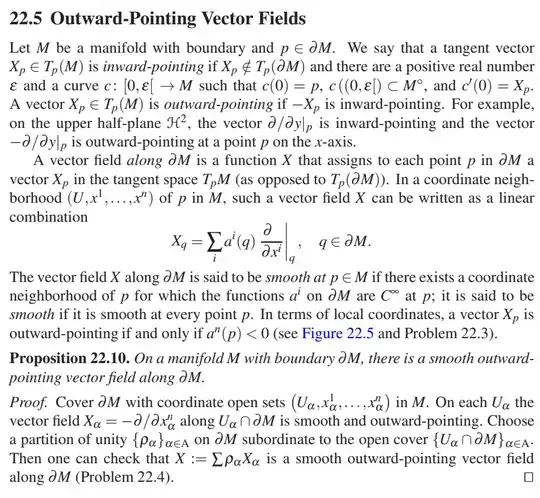My book is An Introduction to Manifolds by Loring W. Tu. The following is an entire subsection (Subsection 22.5) of the section that introduces manifolds with boundary (Section 22, Manifolds with Boundary).
Note: I believe that all manifolds with or without boundary referred in this subsection have unique dimensions by some convention (either it's implicit, or it's explicit a I missed it) in the section (The convention of the book is that manifolds with or without boundary can be locally diffeomorphic to different $\mathbb R^n$'s. See here and here).
According to an errata by Ehssan Khanmohammadi, the only erratum to be made in this subsection is that $c((0,\varepsilon[) \subset M^\circ$ should be changed to $c(]0,\varepsilon[) \subset M^\circ$. I still have several concerns about this subsection.
What exactly is a vector field along $\partial M$, and what is its domain?
Choice 1: It is a mapping whose domain is $\partial M$ and not the whole of $M$ and much like how a manifold with boundary is not a manifold but rather a generalization of a manifold, is not a vector field on $\partial M$ but rather a generalization of a vector field on $\partial M$, which is defined the same as a vector field on any manifold (without boundary) because $\partial M$ is a manifold (without boundary) as proved in Subsection 22.3.
- The generalization is as follows: Let $X$ be a vector field on $\partial M$. $X$ is a mapping whose domain is $\partial M$ and whose image is the tangent bundle $\cup_{p} T_p(\partial M)$ because to each $p \in \partial M$, $X$ assigns $p$ to $X_p \in T_p(\partial M)$. Now, $T_p(\partial M) \subseteq T_pM$, so $X_p \in T_pM$. Therefore, $X$ is a vector field along $\partial M$. However, if we let $Y$ be a vector field along $\partial M$, then for any $p \in \partial M$, we might not have the tangent vector at $Y_p$ to be $Y_p \in T_p(\partial M)$ because we are allowed to have that $Y_p \in T_pM \setminus T_p(\partial M)$ because all we are required is that $Y_p \in T_pM$. Therefore, $Y$ is not necessarily a vector field on $\partial M$.
Choice 2: It is a mapping whose domain is the whole of $M$ and is indeed a vector field on $M$ that has certain properties for its values at $p \in \partial M$ (such as $X_p \in T_pM$ for each $p \in \partial M$). I guess this would mean that $X|_{\partial M}$ isn't a vector field on $\partial M$, which is contrary to some expectation that restrictions of vector fields on $N$, manifolds with or without boundary to subsets $S \subseteq N$ that are manifolds with or without boundary are vector fields on $S$ or something.
In this case, it seems that every vector field on $M$ is a vector field along $\partial M$...but conversely as well. Maybe it is a mapping whose domain is the whole of $M$ but is not necessarily a vector field on $M$.
Update: I think this is the expectation in this link. In the link, the definition of "along" is for a "submanifold" (immersed or embedded) of a manifold which I'm not sure has boundary. I think there's some notion of a "submanifold" of a manifold with boundary that makes $\partial M$ as "submanifold" of $M$ and then I guess for some reason restrictions of vector fields to "submanifolds" are vector fields on the submanifolds, which leads to the generalizing notion of "along"
I think there could be a convention (like with directional derivative) that a vector field along $\partial M$ has domain to be all of $M$ but simply satisfies the property for $p \in \partial M$. See the "global vector field" in the link above: I think Lemma 5 in the link is Tu's Proposition 22.10. Also Lee's Problem 8-4, asked here
Choice 3: Somehow there's an equivalence of being defined on $M$ and only on $\partial M$ with some kind of extension.
Choice 4: Other
I think the next questions shed some light on the answer to this question.
For the local expression of $X$, a vector field along $\partial M$ is the following understanding correct?
- Asked here.
Is this a correct understanding of the smoothness definition?
- Asked here.
$ \ $
Despite the title of the subsection, I don't think there's a definition for outward-pointing vector fields. What is it exactly?
- Asked here
In the proof of Proposition 22.10, is it understood that we cover $\partial M$ by restrictions of the $(U_{\alpha}, x^1_{\alpha}, ..., x^n_{\alpha})$'s like in questions 2 and 3?
- Asked here
Actually, based on Lee's Problem 8-4, asked about here, I think we can interpret Proposition 22.10 without the concept of "along" as follows:
- Asked here
